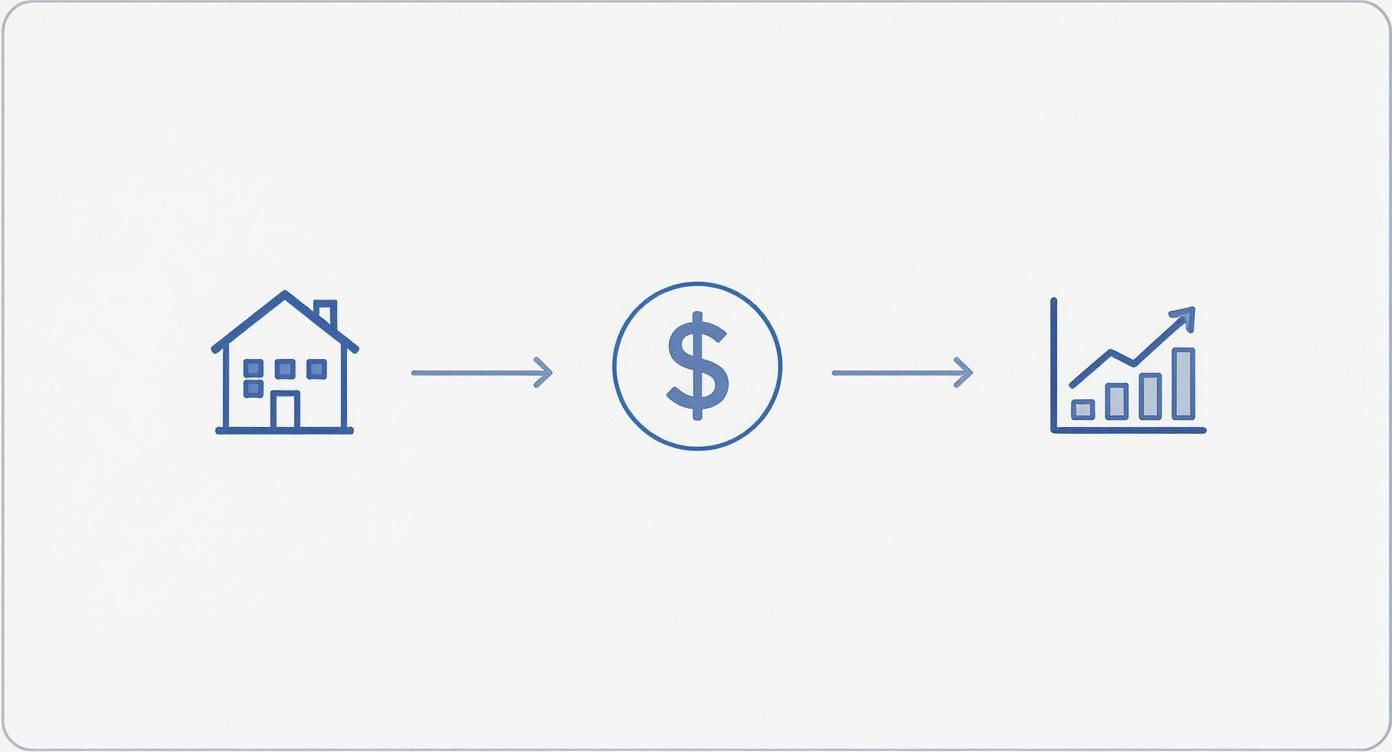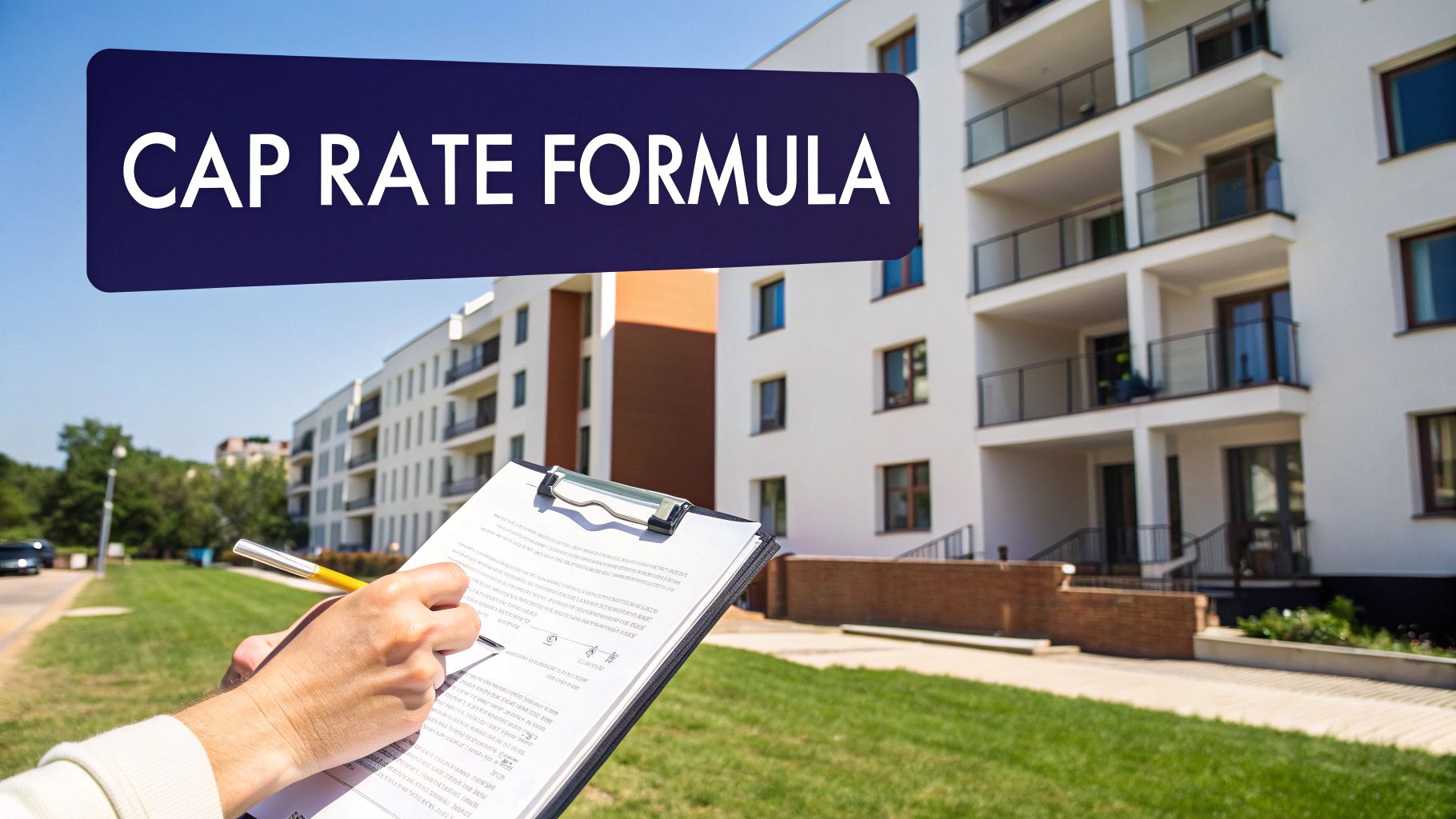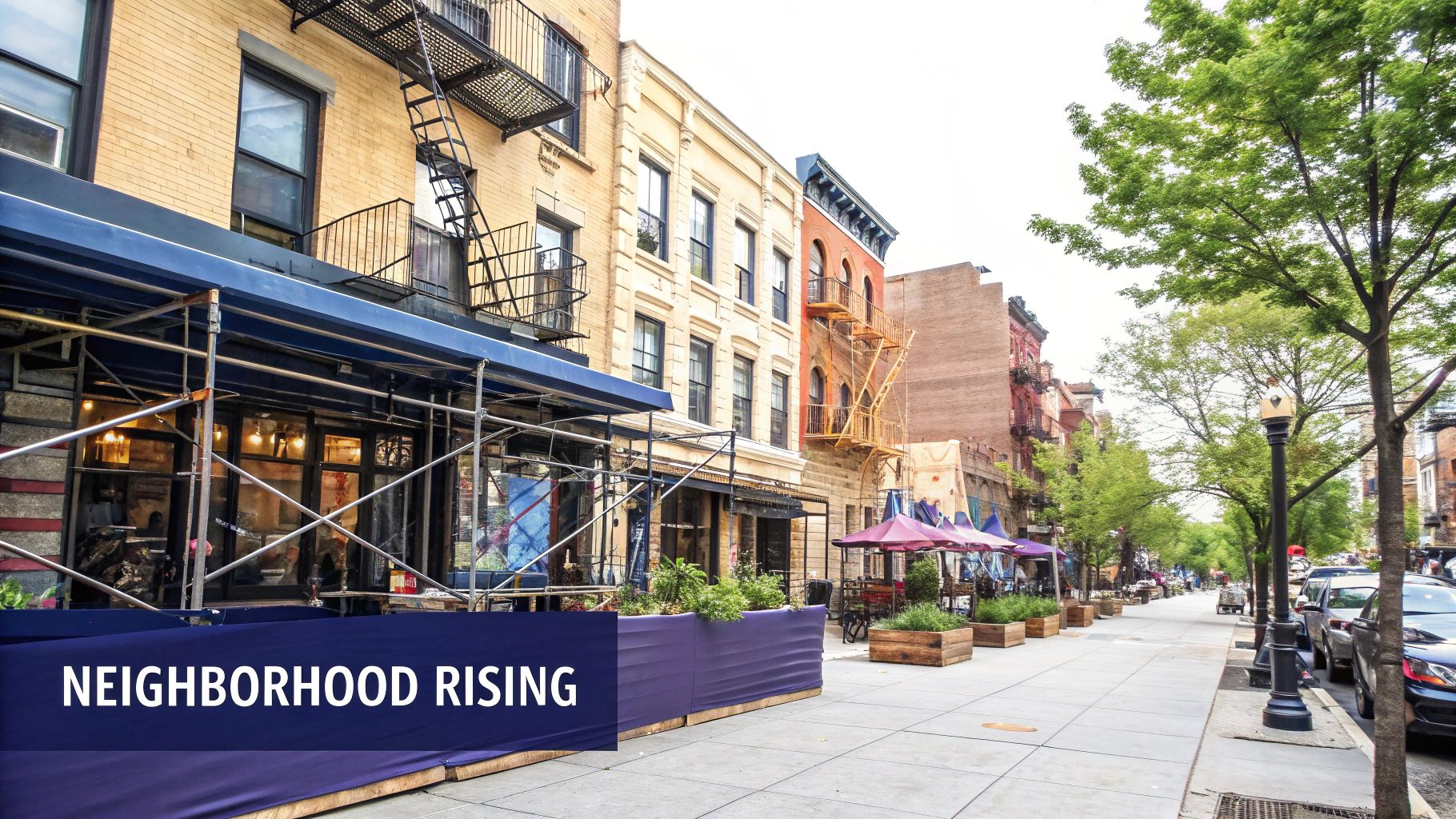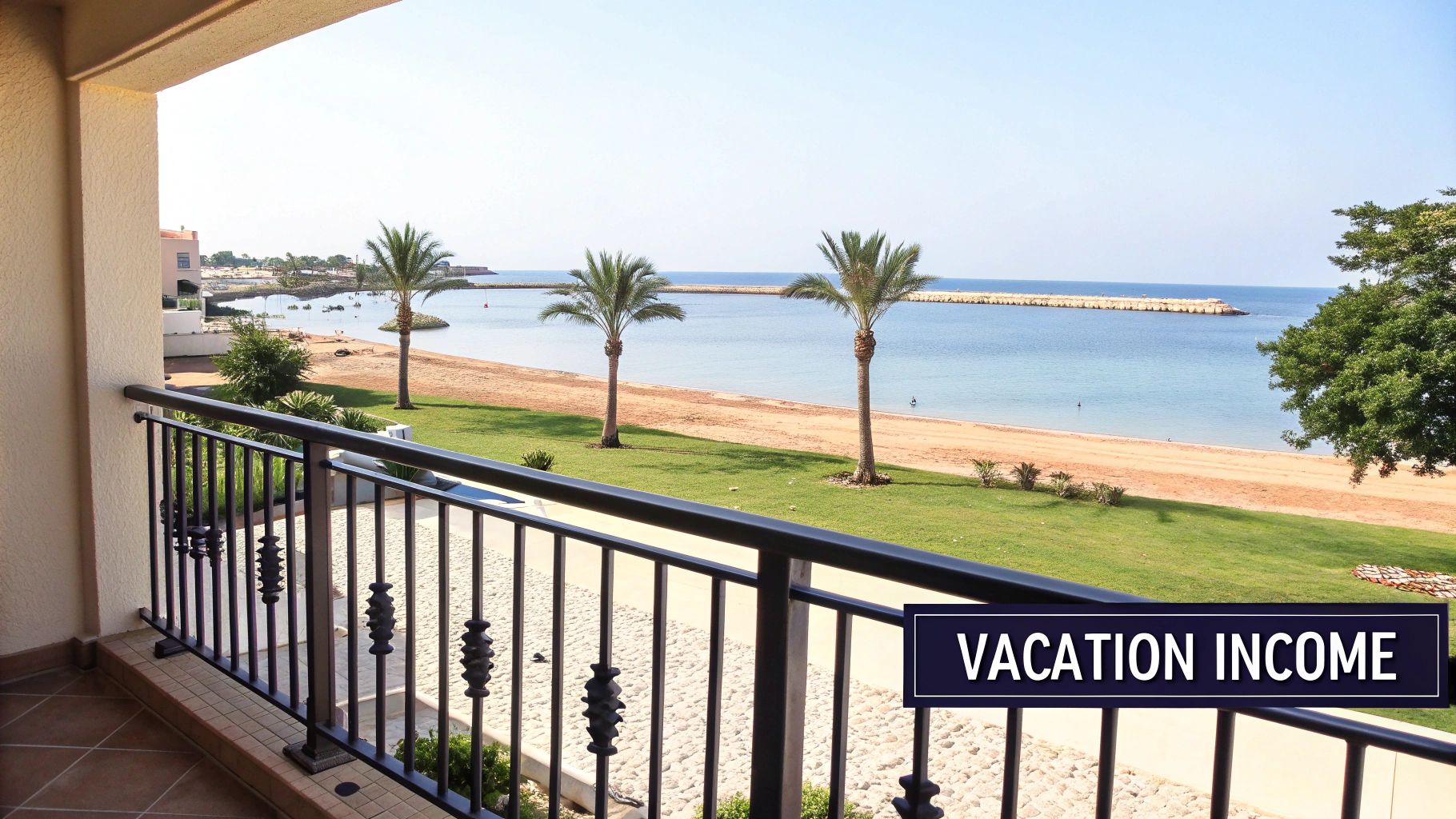Reading Time: 8 min | Good for: Novice & Informed Investors (A, B)
TL;DR: What You Need to Know
What IRR Is: The Internal Rate of Return (IRR) is the true annualized interest rate an investment is projected to generate over its entire life, accounting for all cash inflows and outflows.
Why It Matters: IRR allows investors to compare different real estate deals (e.g., a stable property vs. a development project) on an apples-to-apples basis using a single percentage.
How It's Calculated: Using a timeline of cash flows—from initial investment to final sale—IRR is the discount rate that makes the Net Present Value (NPV) of all those cash flows equal zero.
What's a "Good" IRR?: It depends on the risk. A low-risk "Core" property might target a 7-10% IRR, while a high-risk "Opportunistic" development could aim for 18%+.
Key Limitation: IRR assumes all cash distributions are reinvested at the same high rate, which can be unrealistic. Always use it alongside other metrics like the Equity Multiple.
The internal rate of return, or IRR, is one of the most powerful tools in a real estate investor's toolkit. Put simply, it’s the annualized interest rate an investment is expected to generate over its entire life.
Think of it as the project’s true, all-in growth rate. It’s not just a snapshot; it accounts for every dollar that goes in and every dollar that comes out, which is why it’s a cornerstone for comparing different deals head-to-head. An IRR calculation gives you a single percentage that cuts through the noise and helps you decide if a project clears your personal investment hurdles.
Why IRR Is a Go-To Metric for Real Estate Investors
In the world of private real estate, you'll hear the term IRR thrown around constantly. There's a good reason for that.
Real estate investments aren't simple. They typically start with a huge cash outflow (buying the property), followed by years of smaller, often uneven, cash inflows from rent. And it all wraps up with another big cash inflow when you sell. IRR is one of the few metrics that can take this messy, multi-year timeline and distill it into a single, understandable percentage.
It answers the big question: "What's the real annual return on every dollar I've put into this deal, for the entire time it’s invested?" This is worlds more insightful than basic metrics like ROI, which completely ignore the critical element of time.
Investor Take: A higher IRR is usually a good sign, but it’s not the whole story. You always have to weigh it against the project's risk profile and your own minimum required return, often called a "hurdle rate."
The Power of an Apples-to-Apples Comparison
Let's say you're looking at two totally different opportunities. One is a stable, fully-leased retail center in a great neighborhood. The other is a ground-up apartment development project.
The first offers steady, predictable income right away. The second promises a massive payday, but it’s years down the road. How on earth do you compare them?
This is where IRR shines. It creates a level playing field, giving you a standardized number to judge both deals, no matter how different their timelines or cash flow patterns are.
For those who want to go a bit deeper, IRR is built on the foundation of the discounted cash flow (DCF) model. Understanding how cash flows are valued over time is key to truly grasping an investment's potential and making disciplined decisions with your capital.
To make things even clearer, let's break down the key ideas you need to know.
IRR at a Glance: Key Concepts for Investors
This table boils down the essentials of IRR into plain English, helping you understand not just what it is, but why it's so important for your real estate investment decisions.
Concept | Plain-English Explanation | Why It Matters for Real Estate |
|---|---|---|
Time Value of Money | A dollar today is worth more than a dollar tomorrow. IRR is built on this core principle. | Real estate deals span years. IRR properly values future rental income and sale proceeds in today's dollars. |
Cash Flow, Not Profit | IRR focuses on actual cash moving in and out of the project, not just accounting profits. | This gives you a true picture of an investment's liquidity and performance, ignoring non-cash items like depreciation. |
The "Hurdle Rate" | This is your personal minimum acceptable return. If the IRR is below your hurdle rate, you pass. | It helps you filter deals quickly and ensures you're only spending time on opportunities that meet your goals. |
Single Percentage | IRR boils down a complex series of cash flows over many years into one simple, comparable rate. | It allows you to quickly compare a high-risk development project against a stable, income-producing property. |
Ultimately, while IRR is a fantastic metric for comparison, it's just one piece of the puzzle. It tells you about the rate of return, but not the scale of the return. Always use it alongside other metrics to get a complete view before making any investment decision.
Calculating IRR with a Real Estate Example
Theory is great, but let's be honest—nothing makes a concept like IRR click quite like seeing it in action. So, we're going to walk through a real-world calculation for a hypothetical value-add apartment building.
This is where abstract financial models become a tangible story about an investment. By mapping out every dollar in and every dollar out over the life of the deal, we can nail down the exact annualized return.
Deal Lens Example: A Value-Add Multifamily Project
Imagine Stiltsville Capital is looking at a 50-unit apartment building called "The Sunbelt Lofts." The game plan is simple: buy it, give it a strategic facelift during the first year, bring the rents up to where they should be, and sell it after five years.
To calculate IRR, you first need a timeline of all your cash flows. This is the backbone of the whole analysis, and it has to account for every dollar invested and every dollar returned.
Here’s a simplified look at the projected numbers:
Year 0 (Initial Investment): -$1,000,000. This is the cash investors put in for the down payment and renovation budget. It's a negative number because it's cash out of your pocket.
Year 1: -$50,000. Renovations are in full swing, and the property isn't quite stabilized yet, leading to a small operating loss.
Year 2: +$80,000. The upgrades are done, new tenants are moving in at higher rents, and the property is finally generating positive cash flow.
Year 3: +$95,000. Rents continue to climb as the building settles into its new, improved status.
Year 4: +$110,000. The property is humming along with strong performance and market rent growth.
Year 5 (Sale): +$1,600,000. This is the big one. The property is sold, and this final number includes that year's net operating income plus all the net proceeds from the sale.

This timeline really shows that IRR isn't just a number; it's a metric that tells the story of the entire investment journey, from the day you buy to the day you sell.
Finding the Magic Number: The IRR Calculation
So, what exactly is IRR?
Internal Rate of Return (IRR) is the specific discount rate that makes the Net Present Value (NPV) of all those cash flows—both negative and positive—equal to zero.
Put more simply, it's the interest rate where the value of all your future earnings perfectly balances out your initial investment. For a deeper dive into how these concepts connect, check out our guide on how to calculate a discounted cash flow for real estate success.
Now, you could calculate this by hand, but it would involve a painful amount of trial and error. Thankfully, we don't live in the dark ages.
Today, any investor can use software like Microsoft Excel or Google Sheets. The formula is beautifully simple: just type and select your range of cash flows, from Year 0 to Year 5.
When we plug in our numbers from The Sunbelt Lofts deal , the formula gives us an IRR of 15.2%.
This 15.2% represents the projected annualized rate of return on every single dollar invested over that five-year hold.
For complex projects, accurately forecasting these cash flows—especially that final sale price—is everything. This is why getting professional property valuation services is so critical. It ensures your exit value, which is a massive driver of your IRR, is grounded in solid market data, not just wishful thinking. It's what separates institutional-grade analysis from a speculative bet.
Interpreting Your IRR: What Is a Good Return?
Getting to an IRR number is one thing. Knowing what to do with it is where the real skill comes in. It’s the single most common question we get: "So, what's a good IRR?"
The honest answer? It depends.
There's no magic number that works for every deal. A good return is always measured against the risk you took to get it and your own personal investment goals. This is why the concept of a hurdle rate is so crucial.
A hurdle rate is your personal line in the sand—the absolute minimum return you're willing to accept for a given investment. Think of it as your financial high-jump bar. If a project’s projected IRR can't clear that bar, you walk away, no matter how great the story sounds.
Setting Your Hurdle Rate
So how do you set that bar? A great starting point is your opportunity cost. What could your money be earning somewhere else with a similar level of risk? Many investors benchmark this against long-term returns of the public stock market, then add a little extra to compensate for the fact that private real estate isn't as liquid.
Novice Lens: A simple way to start thinking about your hurdle rate is to ask, "What is the minimum annualized return I need to make this long-term, illiquid real estate investment worthwhile compared to just buying an S&P 500 index fund?"
This framework keeps you disciplined. An 8% IRR might be a fantastic return for a safe, stabilized office building with a long-term tenant. But for a risky ground-up development project? That same 8% would be a complete non-starter. You need to be paid for taking on more uncertainty.
IRR Varies by Strategy
The target IRR for a real estate deal is a direct reflection of its game plan. Lower-risk strategies, like buying a fully-leased apartment building, naturally have lower return targets. On the flip side, higher-risk strategies that involve heavy lifting—like redeveloping an old warehouse—demand much higher potential IRRs.
Historically, private real estate fund returns have danced with market conditions. Data from INREV’s Global IRR Quarterly Index shows that for the last two decades, most non-listed institutional funds have landed somewhere between 8% and 15% annually. You can discover more insights about global IRR benchmarks from INREV.
Typical IRR Targets by Real Estate Strategy
To give you a clearer picture of what to expect, here’s a quick breakdown of how target IRRs line up with common real estate strategies.
Strategy | Risk Profile | Illustrative Target IRR Range (%) |
|---|---|---|
Core | Low | 7% - 10% |
Core-Plus | Low to Moderate | 9% - 12% |
Value-Add | Moderate to High | 12% - 18% |
Opportunistic | High | 18%+ |
Seeing these benchmarks helps you gut-check a deal sponsor's projections. If they’re pitching a low-risk Core deal with an opportunistic-level IRR, it’s time to ask some tough questions.
Remember, IRR is a powerful tool for comparing apples to apples, but it's just one tool. For a complete view of a deal's potential, you should look at it alongside other key metrics. If you want to dive deeper, check out our guide on the meaning of cash-on-cash return for real estate investors.
The Limitations of IRR and When to Use Other Metrics

While the internal rate of return is a powerhouse tool for sizing up real estate deals, savvy investors know it’s not a silver bullet. Relying on IRR alone is like driving with only a speedometer—it tells you how fast you’re going, but not where you're headed or if you have enough gas to get there. To build a truly resilient portfolio, you have to understand its blind spots.
One of the biggest debates around IRR is its built-in reinvestment assumption. The formula automatically assumes that every dollar of positive cash flow you receive is immediately put back to work, earning a return identical to the project's final IRR.
Think about that. For a high-octane opportunistic deal with a projected 18% IRR, the math presumes every distribution gets reinvested at that same 18%. That’s a tall order. Finding your next home-run deal is hard enough, let alone a whole series of them back-to-back.
When IRR Can Be Misleading
The metric can also get a bit quirky in certain scenarios, giving you results that need a second look.
Multiple IRRs: Sometimes, a deal with unusual cash flows—like a big, unexpected capital expense midway through the hold period—can spit out more than one IRR. This creates ambiguity and makes it hard to know which number to trust.
Ignores Scale: IRR is a rate of return, not a measure of wealth created. A small-fry project could boast a 30% IRR and net you $100,000. Meanwhile, a huge institutional deal might deliver a "lower" 15% IRR but generate a massive $10 million in profit. On its own, IRR doesn't tell you the whole story about the dollars in your pocket.
Introducing Complementary Metrics for a Clearer Picture
To get around these weak spots, seasoned investors never rely on a single gauge. They use a full dashboard of metrics. Two of the most powerful partners for IRR are the Equity Multiple and the Modified Internal Rate of Return (MIRR).
Investor Take: Never fall in love with a high IRR in isolation. Always ask, "What is the Equity Multiple?" and "What assumptions are driving this return?" This discipline separates prudent investors from speculators.
The Equity Multiple cuts straight to the chase. It answers one simple question: "How many times will I get my money back?" It’s a clean, powerful way to measure the total cash returned against the total cash invested. For a complete breakdown, you can learn more about the equity multiple formula for real estate in our guide.
Then there's the Modified Internal Rate of Return (MIRR). This metric tackles the reinvestment problem head-on. It lets you plug in a much more realistic rate for reinvesting cash flows—say, a conservative 5% or 6%. This gives you a more sober and achievable forecast.
Using IRR, MIRR, and Equity Multiple together gives you a panoramic view of a deal's potential, balancing speed, scale, and safety.
Comparing Real Estate IRR to Stock Market Returns

Alright, you see a real estate deal promising a 15% internal rate of return. The first thing you probably wonder is, "How does that stack up against just parking my money in an S&P 500 index fund?" It’s a great question—and the most fundamental one for any investor weighing their options.
But here’s the thing: a direct, apples-to-apples comparison can be tricky. It's like comparing a speed boat to a freight ship. They both travel on water, but they’re built for entirely different purposes.
Private real estate is fundamentally different from public stocks. The biggest difference? Liquidity. You can sell shares of a stock in seconds with a few clicks. Selling a commercial building, on the other hand, is a process that takes months.
For tying up your capital in a long-term, illiquid asset, you should demand a higher return. That extra compensation has a name: the illiquidity premium.
The Illiquidity Premium in Context
Think of the illiquidity premium as the reward you get for your patience. It's the extra juice you earn for locking up your money and committing to a long-term strategy. To understand if that premium is worthwhile, it helps to have a baseline. The stock market is a pretty good one.
Looking back, the U.S. stock market has historically delivered real (after-inflation) returns of about 6% to 7% annually. That’s a solid, long-term benchmark for a liquid investment. If you want to dive deeper, the National Bureau of Economic Research has some great data on century-long global stock market performance.
It’s More Than Just a Headline Number
So when a real estate sponsor targets a 15% IRR, they aren't just trying to beat the stock market's 7%. That headline number is a package deal that accounts for a few other key advantages that real estate brings to the table:
Leverage: This is a big one. Real estate allows you to use debt to amplify your returns on equity. It’s a powerful tool that just isn't available to the average stock investor in the same way.
Tax Advantages: Real estate comes with unique perks like depreciation, which can significantly boost your after-tax returns. These tax benefits are a major part of the overall value proposition.
A Different Kind of Risk: The risks in private real estate are tied to the specific property and market, not the daily mood swings of the public markets. You're dealing with execution risk, not a CEO's bad tweet tanking your stock.
Investor Take: A target real estate IRR is more than just a return percentage. It’s a reflection of the potential reward after factoring in illiquidity, the benefits of leverage, tax advantages, and the unique risks of the asset. Your job as an investor is to decide if that all-in package—and the premium it offers—is the right fit for your portfolio.
Investor Checklist: 5 Questions to Ask About IRR
When a sponsor presents an IRR projection, your due diligence is just beginning. Here are five practical questions to ask to look behind the numbers and truly understand the deal.
What are the key assumptions driving the IRR? Focus on rent growth, exit capitalization (cap) rate, and the projected sale date. Small changes here can dramatically swing the IRR. Are these assumptions conservative or aggressive compared to the market?
How sensitive is the IRR to a later sale date or a higher exit cap rate? Ask for a sensitivity analysis. A resilient deal will still perform reasonably well even if the exit isn't perfect. If the IRR plummets with a small delay, the project has little room for error.
What is the projected Equity Multiple alongside the IRR? This tells you the total cash profit potential. A high IRR on a short hold might look great, but if the equity multiple is low (e.g., 1.3x), you haven't made a lot of money in absolute terms.
How is the sponsor's compensation (promote) tied to the IRR? Understand the waterfall structure. Does the sponsor get paid only after investors receive their capital back plus a preferred return? This aligns interests and rewards performance.
What is the "reversion" value as a percentage of total return? "Reversion" is the cash from the final sale. If a huge portion of the return comes from a speculative sale price five years out, the deal is riskier than one with strong, steady cash flow from day one.
At Stiltsville Capital, we believe a deep understanding of metrics like IRR is the foundation of disciplined real estate investing. If you're an accredited investor looking to apply this knowledge to institutional-quality deals in growing markets, we invite you to schedule a confidential call to discuss your investment objectives and how well-structured real estate can be a prudent, resilient component of your long-term wealth strategy.
Information presented is for educational purposes only and does not constitute an offer to sell or a solicitation of an offer to buy securities. Any offering is made only through definitive offering documents (e.g., private placement memorandum, subscription agreement) and is available solely to investors who meet applicable suitability standards, including “Accredited Investor” status under Rule 501 of Regulation D. Investments in private real estate involve risk, including loss of capital, illiquidity, and no guarantee of distributions. Past performance is not indicative of future results. Verification of accredited status is required for participation in Rule 506(c) offerings.











